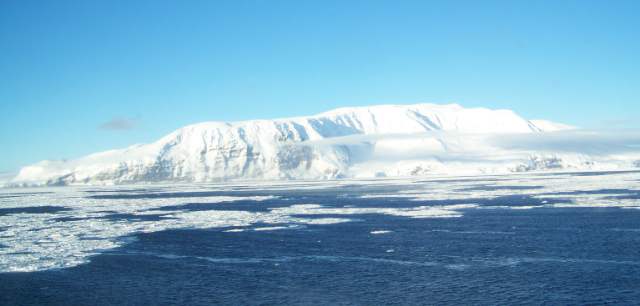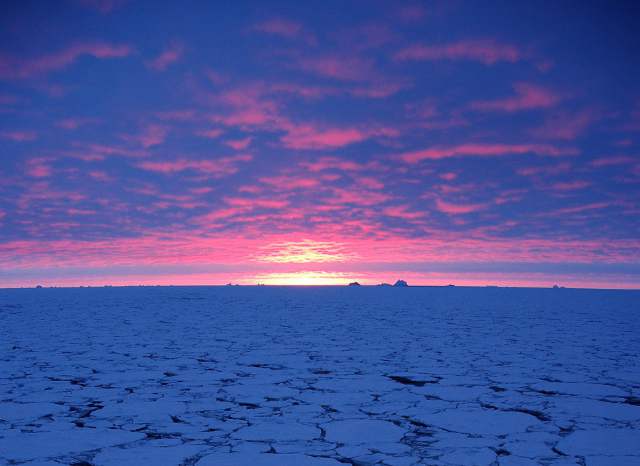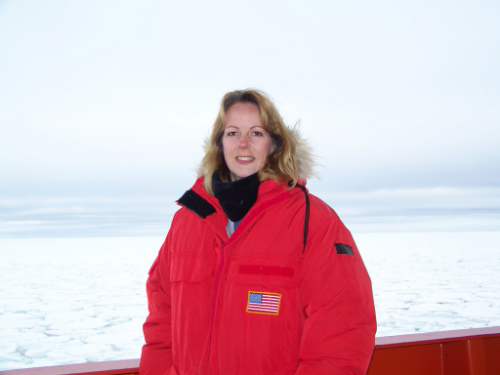Location: From Peter I Island to the Drake PassageStrait, connecting the Atlantic and Pacific oceans between Tierra del Fuego and the South Shetland Islands. Located about 100 mi (160 km) north of the Antarctic Peninsula, it is 600 mi (1,000 km) wide.. Latitude: 60° 20′ S Longitude: 82° 30′ W Air temperature: 1.7 °C (35.1 °F) Wind chill: -13.7 °C (7.3 °F) Wind speed: 25 to 30 knots Water temperature: 3.7 °C (38.7 °F) Barometric pressure: 985.6 mBar ** Antarctic trivia** (answer at the end of this journal entry): 90% of the world’s ice is found in Antarctica. What portion of Earth’s fresh water does this represent?
 **
**
*In a polynya (an area of open water surrounded by ice) near Peter I Island. *
Our planned route home from Ice Station Belgica included a stop at Peter I Island, an ice-covered volcanic island in the Bellingshausen Sea. We reached Peter I Island late on the 25th and stopped for the night. At sunrise we began a circumnavigation around the island so that Brent could conduct a wildlife census on the area. Those up for the sunset and sunrise (only a few hours apart) were treated to a beautiful sight. In this land of blue and white the shimmering pinks and oranges of sunrise and sunset seem almost surreal.
 **
**
Sunset over the ice near Peter I Island.
A flock of snow petrels greeted us as we came close to the island; we’ve seen these birds most every day in the ice, but not in the numbers we saw around Peter I. Snow petrels are my favorite Antarctic birds, except for the penguins, of course! Snow petrels are only found in areas of pack ice where their white feathers give them the perfect camouflage.
 **
**
My last chance to see sea ice.
Before we left the ice I took the chance to spend a little more time outside on the deck enjoying the scenery. Protected from the wind by the ship, it was quite comfortable, even at minus 5 or 6 degrees. The vast expanse of sea ice is really an amazing sight - one that I’ll likely never see again. We were in ice until 5:30 the morning of the 27th. The ice extended further north than expected, and ended rather abruptly. We’ll be in open ocean (and are hoping for calm seas) until the 30th. This is our 4th crossing of the Drake – we "rocked and rolled” a bit the last time across, but the weather forecast is looking promising for this trip.
On the 27th the Antarctic "newbies” were paid a visit by King Neptune’s agent (Chief Scientist Steve) and initiated into the Antarctic Domain. This honor is given to all who sail south of the Antarctic Circle. Each honoree is given a new name to "ingrain into your psyche, forever carry with you, and behave accordingly when you are South of the Antarctic Circle.”
A few notable namings included: • Blake - Polar Skua (For his ability to scrounge anything from anywhere and his relentless drive to keep doing that, even when he doesn’t need to.)
• Martin - Giant Albatross (The bird with the largest wingspan in the Antarctic Ocean…as you can imagine Martin is quite tall.)
• Gary - Red-eared Copepod (When turned upside down, looks just like a Boston Red Sox, in honor of Gary’s citizenship in Red Sox Nation.)
• Penny - Adelie Penguin (Frenetic, a little twitchy, but, undeniably lovable.)
The name chosen for me by King Neptune’s helpers was Emperor Penguin for my "regal and class bearing on and off the sea ice” – those of you who know me personally may find this an interesting characterization given my perpetual clumsiness; good thing no one saw me trip down the stairs last week in my larger-than-life Sorel boots! We even got a fancy certificate that, in part, states that we "having experienced the treacherous and unforgiving reaches of the Antarctic Ocean…have joined the ranks of the elite few who have come before and shall henceforth command due honor and respect from all persons, whales, seals, penguins, fishes, crustaceans, sponges, insignificant microscopic creatures, and other denizens of the Polar Domain.”
Steve says theses initiations formerly included activities that parallel what one might find on a college campus; we’re glad a more civil tone now prevails. Apparently being welcomed into the Antarctic Realm isn’t just an American custom. Jeroen was given the name "Sea Sponge” on his first trip across the Antarctic Circle aboard a German ship.
We should be through the Drake PassageStrait, connecting the Atlantic and Pacific oceans between Tierra del Fuego and the South Shetland Islands. Located about 100 mi (160 km) north of the Antarctic Peninsula, it is 600 mi (1,000 km) wide. and entering the Strait of Magellan on the west side of Chile Tuesday morning, and be in Punta Arenas sometime Wednesday. Final stages of sample and gear packing are happening on board the ship now, as well as report writing and needed rest-getting. Last time I checked Fred had been awake for 50 hours straight finishing lab work and packing boxes; I hope he drank some chamomile tea and is now asleep. Fred is our resident tea expert who has been trying to convince us of the many health benefits of tea…I think he feels sorry for those of us addicted to coffee!
That’s all for now, time to go practice acting like an emperor (penguin, that is)!
Answer to today’s Antarctic trivia question: 90% of the world’s ice is found in Antarctica. What portion of Earth’s fresh water does this represent?
Antarctica’s ice accounts for an amazing 70% of Earth’s fresh water!
Marine mammals and seabirds spotted by Brent: Crabeater seal Leopard seal Minke whale Emperor penguin Adelie penguin Chinstrap penguin Snow petrel Giant petrel Antarctic petrel Blue petrel Cape petrel Southern fulmar Slender-billed prion Antarctic prion


Comments